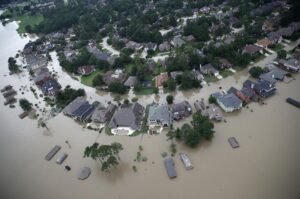Rightly said, there is no greater force than nature, and there is no time more reckless than the seasons. As mentioned, 75% of the world’s population is expected to live in cities by 2050, conquering the coastal cities the most. The coastal cities are often dense and overpopulated due to proximity to water. Take the example of Hurrican Harvey, which left thousands homeless and the residences uninhabitable, and Florida residents are already experiencing the effects of glacial melting and rising sea levels.
Sustainability here is the ability to continue living, through stewardship of human, financial and ecological capitals. Resiliency on the other hands is ensuring that the capital base doesn’t fail catastrophically and still continues to perform at a positive rate, even during the wild weather events. Climate Resiliency allows waterfront building to flood without damaging the major things, and to continue operations when the power goes out.

Let me remind you, being resilient is not a single solution, the concept or a perspective. It is a multifaceted lens that balances activity and reactivity for the solutions and disruptions.
So what does Resilient Design mean?
To design a building with resiliency, it means to start a design process by thinking carefully about the typical scenarios of the building, points of stress due to normal use, disaster situations in the environment that can challenge the integrity of the building and endanger the occupants.
The microclimate always plays a critical role in determining the factors that make a building resilient. For example, New York City has a wet climate, i.e. water is a part of its environmental challenges throughout the year. The most common natural disasters involve water- hurricanes, flooding, storms, and blizzards. Here the resilient buildings need to plan for all types of events as well as day-to-day stress that comes from significant precipitation year-round with humidity and extremely dry interior air. The buildings in New York also need to be seismic resistant, withstand high heat loads in summer, power outages, manmade disasters like terrorism, etc.
Difference between Sustainability and Building Resilience
Resilience:
- Multiples Energy sources
- Multiple water sources
- Disaster resistant design
- More emphasis on passive systems
- Reduced Environmental effects.
- Flood plains evaluation of building locations.
Sustainability:
- Energy Reduction
- Renewable energy production
- Locally-sourced materials
- Community responsibility
- Indoor air quality
- Recycles/ Reclaimed water
- Restoration
A building code is no longer enough, and neither is creating energy-efficient homes. It is obvious that it makes you comfortable, saves money on energy bills and reduces the carbon footprint. But the task today is creating homes, buildings, and communities that are resilient in the face of droughts, flooding and a whole host of natural disasters.

Practical tips for building resilient buildings:
- Locate your project outside of known hazard areas: The sites should be first advocated outside of flood-prone areas so that the design efforts and construction dollars are focused on maximizing operational efficiency.
- Design with flexibility: A design should not be based on past outcomes and past weather data, but also the future predictions must be considered. When you design, you maintain flexibility in operations like smaller units in series, future growth scenarios, and needs.
- Create robust and simple systems: Providing the most robust systems available allows for long-term efficiency. Combining with manual controls wherever possible can also accommodate periods when electrical infrastructure is not available. Using materials and construction methods that are more durable for more energetic weather on increasing the number of weather events.
- Using passive design strategies: Passive design strategies use natural energy sources instead of purchased energy like electricity or natural gas. It also includes, daylighting, natural ventilation, solar energy, and wind energy. Some of these strategies minimize the dependence on HVAC for heating and cooling.
- Use natural resources where possible: To minimize the dependence on traditional sources, designing on-site rainwater storage for irrigation or greywater systems or designing vegetated roofs and rainwater bioswales to reduce urban heat island effect.
- Use of low carbon-input materials and systems: Materials like wood, bamboo, and low-energy masonry should be considered are appropriate building materials.
- Designing buildings for maximum day-lighting: Daylight provides the primary source of lighting for buildings and should be designed to make the most use of it in internal lighting. Internal courtyards, atriums, chowks are good examples of possible daylight effective strategies.
- Design and plan for low energy input: Design and plan for buildings that are built efficiently by manual labor and do not require oil-fueled machines for operations.
- Designing for the use of building systems that can be serviced and maintained with local materials, parts, and labor: Climate change and peak oil, more than likely reduce global trade, and reduce easy access to materials, products and systems from other countries.
- Creating community facilities that serve as resilience hubs: As new community-centered facilities, high-schools, community centers, village halls, provide the necessary infrastructure to allow them to be converted into emergency shelters in extreme weathers.
As building resilience continues to be a buzzword, for anyone who has lived through a tornado, hurricane, flood, or other natural disasters. Adopting policies that recognize and value ecosystems services and protect or restore the capacity to rely on those services. Developing or strengthening regional transportation networks that can serve to transport not only people but also food and other critical needs and that function during times of emergency.
Using an integrated design approach to quality sustainability and resilience practices increase the odds that the design efforts will benefit both the business and buildings. Though the variables which contribute to resilience are often complicated, the sustainability factor is important.
To know more about Architecture Technology, Stay Tuned.

